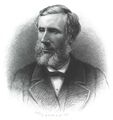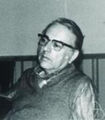Template:Selected anniversaries/December 4: Difference between revisions
No edit summary |
No edit summary |
||
| Line 4: | Line 4: | ||
|File:Red Eyes.jpg|link=Red Eyes|1131: [[Red Eyes]] delivers eulogy for [[Omar Khayyam (nonfiction)|Omar Khayyám]]. | |File:Red Eyes.jpg|link=Red Eyes|1131: [[Red Eyes]] delivers eulogy for [[Omar Khayyam (nonfiction)|Omar Khayyám]]. | ||
||1580 | ||1580: Samuel Argall born ... adventurer and naval officer. | ||
||1576 | ||1576: Georg Joachim Rheticus dies ... mathematician and cartographer. | ||
||1680 | ||1680: Thomas Bartholindies dies ... physician, mathematician, and theologian. | ||
||1791 | ||1791: The first edition of The Observer, the world's first Sunday newspaper, is published. | ||
||1798 | ||1798: Luigi Galvani dies ... physician, physicist, and philosopher. | ||
File:Luigi Galvani.jpg|link=Luigi Galvani (nonfiction)|1798: Physician and physicist [[Luigi Galvani (nonfiction)|Luigi Galvani]] dies. In 1780, he discovered that the muscles of dead frogs' legs twitch when struck by an electrical spark. | File:Luigi Galvani.jpg|link=Luigi Galvani (nonfiction)|1798: Physician and physicist [[Luigi Galvani (nonfiction)|Luigi Galvani]] dies. In 1780, he discovered that the muscles of dead frogs' legs twitch when struck by an electrical spark. | ||
| Line 18: | Line 18: | ||
File:John Tyndall 1878.jpg|link=John Tyndall (nonfiction)|1820: Physicist [[John Tyndall (nonfiction)|John Tyndall]] dies of chloral hydrate overdose. He studied diamagnetism, and made discoveries in the realms of infrared radiation and the physical properties of air. | File:John Tyndall 1878.jpg|link=John Tyndall (nonfiction)|1820: Physicist [[John Tyndall (nonfiction)|John Tyndall]] dies of chloral hydrate overdose. He studied diamagnetism, and made discoveries in the realms of infrared radiation and the physical properties of air. | ||
||1850 | ||1850: William Sturgeon dies ... physicist, invented the electric motor. | ||
||1872 | ||1872: The crewless American ship Mary Celeste is found by the Canadian brig Dei Gratia. The ship had been abandoned for nine days but was only slightly damaged. | ||
||1875 | ||1875: Notorious New York City politician Boss Tweed escapes from prison; he is later recaptured in Spain. | ||
||1893 | ||1893: John Tyndall dies ... physicist and chemist. | ||
||Sir Kariamanickam Srinivasa Krishnan | ||1898: Sir Kariamanickam Srinivasa Krishnan dies ... physicist. He was a co-discoverer of Raman scattering, for which his mentor C. V. Raman was awarded the 1930 Nobel Prize in Physics. | ||
| | ||1935: Charles Richet dies ... physiologist, bacteriologist and pathologist who was awarded the 1913 Nobel Prize for Physiology or Medicine. He coined (1902) the term "anaphylaxis" meaning "against protection" to describe the subject of his research, when he found a second vaccinating dose of sea anemone toxin caused a dog's death. Instead of producing protection, as expected in the normal response to vaccination, the first dose had produced a life-threatening sensitivity. This led to an understanding a variety of allergic reactions, hay-fever and asthma. His other interests included aviation: attracted by Marey's experiments on bird flight, Richet participated in the design and construction of one of the first airplanes to leave the ground under its own power. Pic. | ||
File:Nathan Jacobson.jpg|link=Nathan Jacobson (nonfiction)|1942: Mathematician and crime-fighter [[Nathan Jacobson (nonfiction)|Nathan Jacobson]] uses structure theory of rings without finiteness conditions to detect and prevent [[crimes against mathematical constants]]. | File:Nathan Jacobson.jpg|link=Nathan Jacobson (nonfiction)|1942: Mathematician and crime-fighter [[Nathan Jacobson (nonfiction)|Nathan Jacobson]] uses structure theory of rings without finiteness conditions to detect and prevent [[crimes against mathematical constants]]. | ||
||Thomas Hunt Morgan | ||1945: Thomas Hunt Morgan dies ... evolutionary biologist, geneticist, embryologist, and science author who won the Nobel Prize in Physiology or Medicine in 1933 for discoveries elucidating the role that the chromosome plays in heredity. Pic. | ||
||1948 | ||1948: Frank Benford dies ... physicist and engineer. | ||
||1969 | ||1969: Black Panther Party members Fred Hampton and Mark Clark are shot and killed during a raid by 14 Chicago police officers. | ||
File:Pioneer 10 construction.jpg|link=Pioneer 10 (nonfiction)|1973: The ''[[Pioneer 10 (nonfiction)|Pioneer 10]]'' space probe makes its closest approach to the planet Jupiter, at a range of about 132,252 kilometers (82,178 mi). | File:Pioneer 10 construction.jpg|link=Pioneer 10 (nonfiction)|1973: The ''[[Pioneer 10 (nonfiction)|Pioneer 10]]'' space probe makes its closest approach to the planet Jupiter, at a range of about 132,252 kilometers (82,178 mi). | ||
||Samuel Abraham Goudsmit | ||1978: Samuel Abraham Goudsmit dies ... physicist famous for jointly proposing the concept of electron spin with George Eugene Uhlenbeck in 1925. | ||
||1998 | ||1998: The Unity Module, the second module of the International Space Station, is launched. | ||
File:George_Brecht.jpg|link=George Brecht (nonfiction)|2005: Chemist, composer, and criminal investigator [[George Brecht (nonfiction)|George Brecht]] uses conceptual art to detect and prevent [[crimes against chemistry]]. | File:George_Brecht.jpg|link=George Brecht (nonfiction)|2005: Chemist, composer, and criminal investigator [[George Brecht (nonfiction)|George Brecht]] uses conceptual art to detect and prevent [[crimes against chemistry]]. | ||
Revision as of 13:01, 19 August 2018
1131: Polymath, scholar, mathematician, astronomer, philosopher, and poet Omar Khayyám dies.
1798: Physician and physicist Luigi Galvani dies. In 1780, he discovered that the muscles of dead frogs' legs twitch when struck by an electrical spark.
1820: Physicist John Tyndall dies of chloral hydrate overdose. He studied diamagnetism, and made discoveries in the realms of infrared radiation and the physical properties of air.
1942: Mathematician and crime-fighter Nathan Jacobson uses structure theory of rings without finiteness conditions to detect and prevent crimes against mathematical constants.
1973: The Pioneer 10 space probe makes its closest approach to the planet Jupiter, at a range of about 132,252 kilometers (82,178 mi).
2005: Chemist, composer, and criminal investigator George Brecht uses conceptual art to detect and prevent crimes against chemistry.
2016: London Has Swollen wins Sundance Film Festival award.






